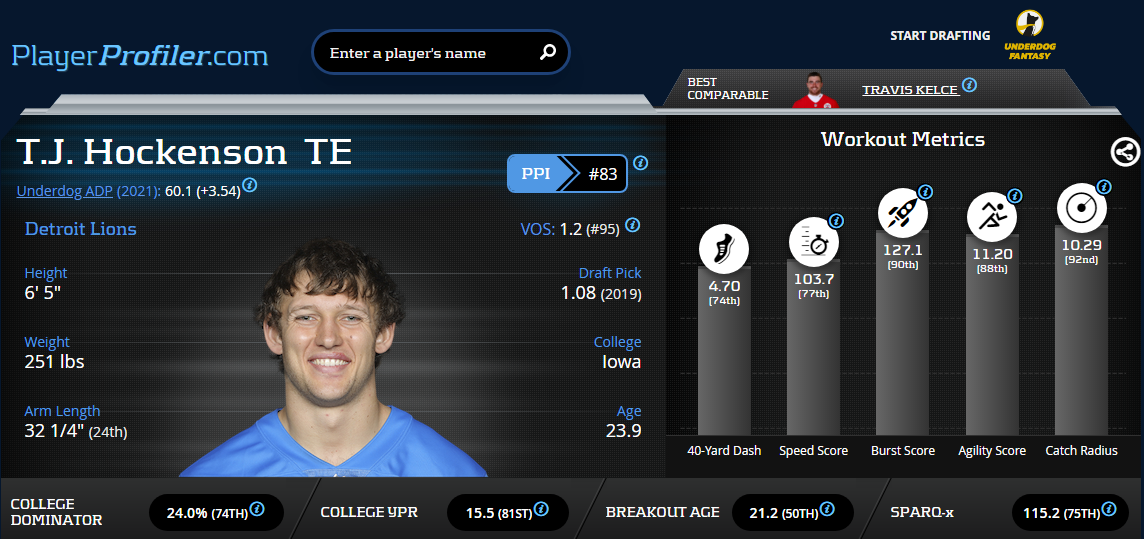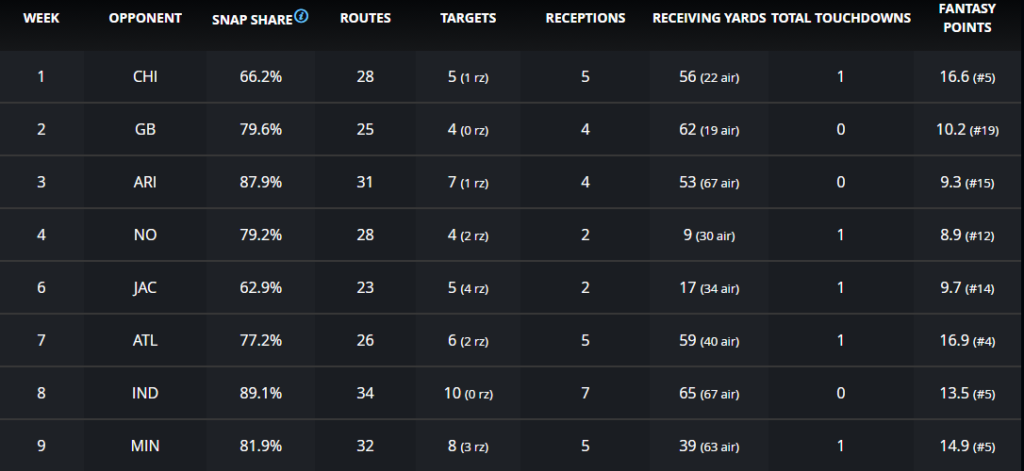T.J. Hockenson might have unrealistic expectations entering 2021. A 24-year-old selected as the first tight end off the board in 2018 and entering his third season, many believe he will be the focal point of the Detroit Lions passing attack after finishing as TE5 with 67 receptions for 723 yards and six touchdowns, all good for second-most on the team.
Hockenson joins elite company for tight ends in their second year. He had the seventh-best finish since 2010 and the 17th-best in NFL history. Of the list above, only Aaron Hernadez, due to off-field issues, didn’t finish as a top 12 tight end at least three times. However, Hockenson isn’t walking into an ideal situation as some might think.
There have been few cases where a third-year tight end is arguably the best pass-catcher on the roster. Tony Gonzalez in 1999 is the best example, but they still had Joe Horn, who broke out a year after, and Derrick Alexander, who had five consecutive 800-plus yard seasons. The Chiefs had a rookie head coach in Gunther Cunningham, but they had winning records in nine of the previous ten seasons with Marty Schottenheimer. Compared to the recent dysfunction of the Lions, the Chiefs were living the dream.
Detroit’s Depleted Roster
Outside of the Texans, the Lions may be the most barren team in the NFL. Aside from Breshad Perriman, who is on his fifth team, the highest-drafted receiver on the roster is 2021 fourth-round pick Amon-Ra St. Brown. Miscasts from around the league and young players who have yet to develop make up their defense. Undrafted free agents fill out over half of the entire roster. General manager Brad Holmes and head coach Dan Campbell have their work cut out for them, but most of these issues will be solved beyond 2021. This year, they will have to work with their current build.
With this barren roster should come opportunity. Negative Game Scripts, target volume, and offensive coordinator Anthony Lynn all create excitement for pass-catchers in this offense. T.J. Hockenson seems to be at the forefront of this attack. But should he be the focal point?
Is there another Travis Kelce coming? 😳 pic.twitter.com/ZaHQmbPrjV
— PlayerProfiler (@rotounderworld) June 7, 2021
In 2020 Hockenson did well with the ball in his hands. He had 101 (No. 5 among qualified tight ends) targets, 67 (No. 4) receptions, and 723 (No. 3) receiving yards, with 328 (No. 4) yards after catch. However, the 5.4 (No. 15) Target Quality rating and 7.48 (No. 15) Target Accuracy hurt his overall efficiency.
Why the Concern in 2021?
Highest Drop Rate in 2020 ?
1️⃣ Trey Burton: 12.8%
2️⃣ TJ Hockenson: 10.9% pic.twitter.com/ygcA0TwbJk— RotoUnderworld (@rotounderworld) April 21, 2021
The glaring concern with T.J. Hockenson‘s game came with his drops. A large portion of these routes were in traffic, which increased the level of difficulty. However, he needs to improve on focus drops, which accounted for over 50-percent. Additionally, the majority came within ten yards from the line of scrimmage.
TJ Hockenson led all Tight Ends with 11 drops in 2020
Most in the NFL ? pic.twitter.com/jPfZGeUPKI
— RotoUnderworld (@rotounderworld) February 10, 2021
Drops aren’t the only thing to cause hesitation when trusting Hockenson. Significant changes are coming to the Lions offense. Offensive coordinator Anthony Lynn is installing a new system. With the Bills, Lynn relied more heavily on the run game. The primary reason behind this was quarterback Tyrod Taylor being more of a mobile quarterback along with a lack of options at receiver. In 2015, Taylor completed passes to ten different receivers, while none played more than 13 games. In 2016, Taylor completed passes to nine receivers, with none playing more than ten games. To say Lynn was at a disadvantage is an understatement.
As for Lynn’s time with the Chargers, as discussed in D’Andre Swift versus J.K. Dobbins, he had an uneven play calling tenure. Here’s a refresher:
When coming in as the head coach in 2017, he kept Ken Whisenhunt to call the plays. They finished middle of the road in plays per game in 2017, followed by No. 28 the following year. The Chargers fired Whisenhunt midway through the 2019 season with Shane Steichen taking over, but not without a heavy dose of input from Lynn. They still finished in the bottom half in 2019, but the game speed skyrocketed with Justin Herbert at the helm last season. They finished No. 1, running over 70 plays per game.
As a former running back, Lynn has typically emphasized a robust run game approach. However, during these four years, the Chargers, although No. 15 or worse in plays run in three of four years, were top ten in pass attempts per game three times. Only in 2020 did they finish better than No. 19 in rush attempts per game.
Will the Offense Call Enough Plays?
We won’t see as much scrambling as we did with the Bills while Jared Goff was quarterback. However, expect the tempo to be similar to 2020 versus previous years, with projected Game Script forcing them to keep up in potential shootouts. They should finish at the top of the league in plays run per game. The thing to be looked at now is Lynn’s tight end usage.
Even though Hunter Henry never broke out under Lynn, he did see plenty of opportunity. Henry lined up as a wide receiver on 49.1-percent of his snaps. While he didn’t dominate targets like T.J. Hockenson, Henry had an 81.7-percent (No. 9) Route Participation mark compared to Hockenson’s No. 12-ranked 77.7-percent. With the lack of receiving options in Detroit, Hockenson could easily surpass 81.7-percent in 2021, while maintaining last season’s 18.0-percent (No. 10) Target Share.
What About the Efficiency?
Jared Goff is widely viewed as a downgrade from Matthew Stafford, and rightfully so. Aside from completion percentage, Goff was worse in every category last year. However, when he targeted the tight end, he was a different quarterback. Goff averaged a 111.24 quarterback rating over 111 passing attempts while targeting the position. He completed 81 passes for 908 yards, six touchdowns, and only one interception to Gerald Everett, Tyler Higbee, and Johnny Mundt.
T.J. Hockenson is athletically superior and should have far more plays scripted for him to be the primary option. His physical profile, combined with his college production and draft capital, puts him in potentially elite company. Only Kyle Pitts, Tyler Eifert, Noah Fant, and Vernon Davis, all first-round NFL Draft picks, have equaled or bettered Hockenson’s 115.2 (75th-percentile) SPARQ-x score, 24.0-percent (74th-percentile) College Dominator Rating, and 15.2-percent College Target Share.
With the way tight ends are utilized as receivers, the argument that they need multiple years to develop is overblown. From the first year to the second, there’s a massive increase in fantasy value. Since 2010, there have been 11 more sophomore campaigns than rookie ones which finished with over 145.3 (TE1 in 2020) fantasy points, including Hockenson’s massive jump to TE5. So tight ends might not take as long to develop as we are led to believe.
While we view tight ends as developmental prospects, the most efficient years across the board seem to be their second through their fifth. Referencing back to 2010, a minimum of 13 tight ends would have finished with TE1 numbers throughout each campaign in years two through five. The single best campaign of a tight ends career seems to be their third season, with 24 players finishing with over 145.3 fantasy points. There were 15 players who hit that mark in their fourth and fifth seasons. Hockenson is poised for the perfect breakout campaign.
Separation of The Great and The Elite
The recent success in years two through five is a combination of two factors. The first is allowing young tight ends to play more of a pass-catching role immediately. While they continue to improve their blocking, getting the ball in their hands in mismatch situations against slower linebackers or smaller defensive backs, instead of asking them to pick up blitzes, allows for immediate production. In 2020, 32 tight ends had at least a 50.0-percent Route Participation rate.
The second factor is where most tight ends tend to separate themselves as elite: their ability to stay healthy and on the field. Of the 24 tight ends who would have finished as a TE1 in their third year, only seven repeated this feat in their fourth (five are ineligible due to 2020 being their third season). Of the 12 remaining, half missed at least six games in their fourth year, and only three of the seven mentioned went on to produce top 12 numbers in year five. Those three were Zach Ertz, Travis Kelce, and Jimmy Graham; all top eight in history for Fantasy Points Per Game.
Outside of one high ankle sprain (warning: image is graphic) in 2019, T.J. Hockenson has shown no signs of slowing up or being a health risk. The notion that his ankle injury was severe enough to result in a slow start to 2020 wasn’t the case being that he started the first nine weeks as the overall TE3.
Conclusion
There is no doubt the volume will be plentiful for T.J. Hockenson in 2021. He can still make plays after the catch, so efficiency isn’t a concern. If Jared Goff continues to play well with tight ends, and Hockenson can improve his Drop Rate, the efficiency will be even more mouth-watering. The most difficult thing to predict is for the position is injuries. However, he seems to be as reliable as they come.
TJ Hockenson has finished with 5+ targets in 17 of 28 career games ?
➡️ https://t.co/wNAYaKKXgX pic.twitter.com/jU3hyzmKHf
— RotoUnderworld (@rotounderworld) June 17, 2021








